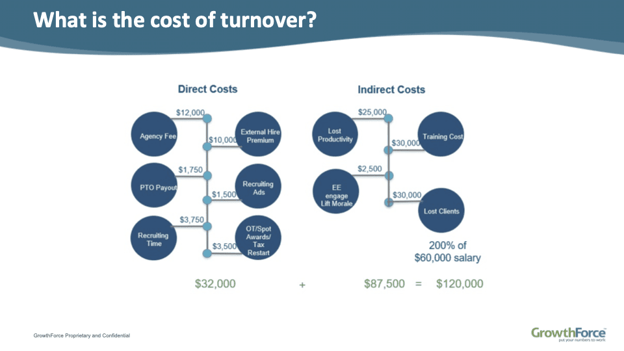6 min read

Your organization is growing quickly and you have an opening in a leadership position in your company. When you know it's time to hire another employee, how can you determine whether it's better to promote from within and hire someone new for an entry-level position or to fill the leadership role with an external hire?
|
Key Takeaways
|
The answer to that question largely depends on your business's specific needs at the moment, the employees who are currently working for you, and the applicant pool for external hires. When deciding whether to promote from within or hire externally, consider the following...
Advantages Of Businesses Promoting Employees From Within
1. Increase Retention Rates to Prevent Post-Pandemic Turnover
Microsoft's 2021 Work Trend Index looked at 30,000 people in 31 countries and found more than 40% of employees in the global workforce were seriously considering leaving their jobs this year [1]. This post-pandemic turnover surge has been coined "The Great Resignation," and it's something that every employer needs to take very seriously.

Read More: More Than You Think: The Cost Of Employee Turnover
Employee turnover is extremely expensive- and small businesses feel it the most. Why? Most of their employees run on tribal knowledge – when a member of the tribe leaves, so, too, does the knowledge.
Replacing a high-level employee can actually cost about 150% of the employee's salary! Turnover results in the direct costs of hiring a new employee in addition to the indirect costs of lost internal expertise, customer continuity, customer satisfaction, and production lags. [2]
At potentially 41%, turnover-related costs could be high enough to cripple cash flow and put many businesses out of business. When you promote from within, you open up new opportunities for your employees and you'll save money, too, because the cost of hiring to fill entry-level positions will also be much lower.
2. Increase Employee Satisfaction and Workplace Morale
Feeling dissatisfied with their jobs is one of the primary reasons why employees are quitting in unprecedentedly large numbers.
To keep employees happy and increase workplace morale, you need to make sure you're meeting all of your employees' needs so that you're helping to give them the opportunity to lead happy and fulfilling lives. In the modern workplace, this means not only paying a fair and livable wage so that they can have their basic needs (food, housing, and clothing) met, but also providing benefits that can meet higher needs.
Read More: Lower Turnover & Boost Profits By Honoring Maslow’s Hierarchy Of Needs
Promoting from within is a great way to satisfy the top of your employees' hierarchy of needs, self-actualization, by offering opportunities for self-improvement, career development, creativity, and professional opportunities inside your workplace.
3. Internal Employees Are Already a Good Fit
Hiring outside of your company introduces the element of a wildcard. Sure, you'll ask for a resume and you'll conduct interviews, but you won't actually know whether a new hire is a good fit for your company culture until they start.
When you're hiring externally to fill a high-level position, that's a pretty big risk to take. Choosing the wrong person to fill a leadership position not only leads to productivity problems but can also lead to the fast spread of negativity throughout your workplace morale and culture.
When you promote internally, there will be some unknown factors to consider, but you will already know that the person you've chosen for the job is a perfect fit for your workplace culture and the continued cultivation of positive morale.
Read More: Maximize Your Business Profit With High Performing Teams
4. Greater Adaptability
In addition to fitting your culture, internal hires already know the ins and outs of your business. Of course, they'll have a few things to learn in order to be successful in a new position in your business, but they'll adapt quickly thanks to their existing familiarity with the position.
5. Improve Employer Brand
When you interview an applicant, one of the questions they'll likely ask you is whether you promote from within or hire externally because they want to know what kinds of opportunities for career advancement and development you offer.
Hiring internally creates opportunities for goal-setting with your employees in addition to increased stability in their lives when they know they could potentially remain with the same employer for the entirety of their careers.
When you not only offer a new hire an attractive job in the present but also opportunities for career growth in the future, you immediately become a much more attractive employer. As a result, you'll have the top talent in your industry competing for positions with your company.
Employee Development Ideas to Boost Your Internal Promotion Model
Creating an employee development program can help you better evaluate and measure your internal employees' potential for success in leadership positions and eagerness for promotion selection overall.
Plus, offering opportunities for career development will also increase your employees' job satisfaction, increasing retention rates, while also improving your brand as an employer, helping you attract external hires of higher quality.
Start With Cascading Goals
To help your employees develop their careers, start by creating cascading goals inside your company. Cascading goals include long-term goals that satisfy the big-picture plans for your business while also mapping out the path to short-term goals and benchmarks that will move your entire organization in the right direction toward success.
Read More: 10 Tips To Help Your Employees Set Better Goals
Once you know your long-term goals and have set short-term benchmarks to get there, identify the skill sets your employees need to achieve these goals and look for personal, career, and leadership development programs that can enhance employee satisfaction, while also boosting productivity, and increasing organization-wide alignment around common goals.
Pay Close Attention To Employee Engagement
The proof is in the numbers: companies with high employee engagement are 21% more profitable. [3] Why? Employee engagement increases productivity in the workplace, which shows up on your bottom line.
Let’s go back to the basics- we all remember learning about Maslow’s Hierarchy of Needs. What most people don’t know is the same principles apply to employee engagement in the workplace.
Following Maslow’s hierarchy, the basic principles state that a person cannot strive for higher needs until the more basic needs have been met. For example, a person must worry about obtaining shelter and food, before they can be concerned with belonging, feeling confident, or challenging themselves on a higher level.
Similarly, you can meet your employees' most basic needs by offering fair monetary compensation and benefits. To get the most out of employees, it’s important to foster their self-actualization through career development opportunities. This self-fulfillment will boost their productivity, and in turn, boost your bottom line.
If you are not offering your employees a career development plan to help achieve their “higher purpose”, they will look for it somewhere else.
The Bottom Line: You Can’t Manage What You Don’t Measure
Your people are your biggest asset. When you have a “people-first” strategy, you’ll get a group of people who are committed to helping the organization be better.
It starts by getting the right management reports and KPIs at your fingertips. Beyond tracking your turnover rate, you should identify and monitor additional employee-related metrics to ensure your organization is on track.
When your financial management and human capital management strategies are working hand-in-hand, you’ll begin to see an increase in employee engagement, improved retention rates, and an ROI that increases your bottom line.
[1] https://www.microsoft.com/en-us/worklab/work-trend-index/hybrid-work
[3] https://blog.smarp.com/what-is-the-true-cost-of-poor-employee-communication



![How People Drive Profit [GUIDE] 6 Key Company and People KPIs you need to make Data-Driven Decisions...](https://no-cache.hubspot.com/cta/default/549461/a4c91ab8-e371-4c8a-b4dd-8bd96d5105f0.png)

